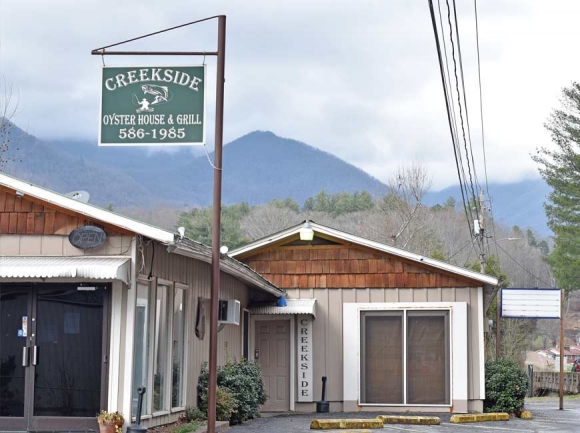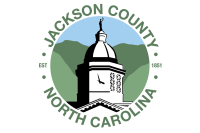Changes to water/sewer tap-on fees could impact Sylva economy
 Creekside Oyster House & Grill owner George Neslen hopes to expand to a new location but says up-front sewer and water fees of nearly $50,000 could make that impossible. Holly Kays photo
Creekside Oyster House & Grill owner George Neslen hopes to expand to a new location but says up-front sewer and water fees of nearly $50,000 could make that impossible. Holly Kays photo
Jackson County’s controversially high water and sewer fees could remain unchanged following implementation of a 2017 state law that was designed to ensure that these fees are calculated fairly and consistently.
The law, which will go into effect in July, requires North Carolina water and sewer utilities that charge upfront fees for new users to hire an independent engineering or financial consultant. The consultant must then determine, using criteria outlined in the law, the maximum fee that utility should be able to charge. Utilities can set their fees anywhere between $0 and the maximum. During a Feb. 13 work session, board members for the Tuckaseigee Water and Sewer Authority heard the preliminary results of the study completed by Asheville-based WR-Martin, formerly called Martin-McGill.
“Your fees right now are less than what these are,” Steven Miller, senior consultant for WR-Martin, told the board of his calculations. “If you follow the system buy-in approach, you can continue charging the fees you’ve been charging in the past. What you cannot do is charge anything that’s higher than what’s here.”
Calculating the max
The law gives utilities a choice of three ways to calculate maximum fees — the system buy-in approach, the incremental approach or a hybrid between the two. The system buy-in approach calculates the value of the existing infrastructure and from there determines how much each new user should have to pay to “buy into” — essentially, become a shareholder in — the system. The incremental approach relies on the utility’s 20-year capital improvement plan and calculates, based on best guesses of which projects will be completed in that time and how much they will cost, how much new users must pay to provide for needed expansions in that timeframe.
Board members could choose to set maximum fees based on any of the three choices, but during the Feb. 13 meeting some apparent advantages emerged in using the system buy-in approach. The law provides more leeway for how the fees can be spent when calculated that way, and estimates of current assets based on audited financial information are a lot more reliable than estimates of how much a project planned for 15 years down the road might actually cost, or whether said project will truly be completed in 15 years rather than in 20 or 25.
Related Items
To arrive at his estimates for the system buy-in method, Miller calculated the depreciated value of everything that goes into TWSA’s water and sewer systems, subtracting out grants and outstanding debt principal. Items catalogued include computer equipment, furniture and fixtures, land, lines, vehicles, buildings, treatment plants and more. Miller then calculated the number of “user equivalents” — a residential user counts as one “user equivalent,” and he used the average consumption of residential users in the system to determine how many gallons per day one “user equivalent” is worth. Commercial users were then converted into a number of “user equivalents” based on how many multiples of that average consumption figure they used.
Dividing the total value by the number of “user equivalents” then yielded the maximum upfront fee — called a system development fee under the new law, rather than an impact fee — TWSA could charge.
Miller performed separate calculations for the southern system, which serves the Cashiers area, and the northern system, which serves the lower-elevation portions of the county.
He determined that the highest system development fee TWSA could charge northern system users under the system buy-in approach would be $3,965 for water and $5,942 for sewer. Both maximums are based on 5/8-inch meters. For the southern system, the maximum charge to connect a residential sewer user would be $10,853, with connections for non-residential customers based on projected peak flow. The southern system does not provide water connections.
The incremental method — which would involve determining costs of needed capital projects over the next 20 years and dividing those by the number of “user equivalents” — yielded slightly different results, with a maximum charge of $2,235 for northern water users and $11,063 for southern sewer users. However, the method was unable to generate a fee for northern sewer.
Miller emphasized that the maximum fees are just that — legal maximums. In some cases, they turned out almost ridiculously high, such as in the results for southern sewer users.
“Nobody is going to charge a fee that high for system development, but according to calculations that’s your ceiling you’ve got to work with,” he said.
So, as TWSA moves forward with its planning for the 2018-19 budget, the question is this: will up-front fees rise, decrease or stay the same?
Impediment to expansion
George Neslen has owned Creekside Oyster House & Grill for about two-and-a-half years, growing the nearly five-year-old business to the point that it’s running out of parking and seating at its current location along Skyland Drive. He’s looking to expand and has been eying a now-vacant Main Street Sylva location owned by resident Jean Ensley, who would very much like to sell it to him.
The obstacle? Impact fees. Paying water and sewer impact fees plus costs for meter and tap installation would cost Neslen $48,265.
“That number is what I’m worried about. I think it will hinder this project to the point I might not be able to achieve it,” Neslen told the TWSA board during public comment Feb. 13. “I would really like to stay in this town and this community. This is where I was born and raised, opened my business — it’s where I’m raising my family, and I fear that these tap-on fees are creating an environment that is not helpful or encouraging to businesses or the expansion of our economy.”
Neslen told the board that he had found himself in a tricky place — he wants to expand, and he wants to expand in Sylva, but nearly $50,000 in tap-on fees is a deal-breaker. However, if the upfront fee structure is set to change come July, that puts him in a kind of limbo when he’d really like to be actively pursuing the expansion.
And by the way, he said, couldn’t he just be allowed to rent the allocation? TWSA has an allocation rental policy that allows existing users looking to expand their capacity to pay a monthly fee rather than an upfront sum, but Neslen said he was told that policy wouldn’t apply to him because he’s planning to build a new building rather than increase capacity at an existing building. However, he said, the property in question does have an existing building with water and sewer access, and it’s zoned commercially — even though he wouldn’t be operating out of the building that contains the taps, he asked, isn’t that still enough for him to fall under the rental policy?
“I think it’s a good opportunity not just for me but for this town and community,” he said. “There’s very few developable properties left in this small town, and I think it would be a shame for us not to try to develop that further.”
Later in the discussion, Harbaugh said that the discussion of rental allocation was “premature” and that he would need to receive Neslen’s application before determining whether the rental policy could apply. Neslen said he had all the information needed for Harbaugh to make that decision but hadn’t officially applied to avoid incurring fees before he was sure he’d be able to proceed.
Neslen received substantial support in his request from other community members, including a letter on Town of Sylva letterhead signed by Mayor Lynda Sossamon and written following a Feb. 8 board discussion spurred by public comment from Neslen.
“We are concerned that TWSA’s high impact fees are hindering our community’s growth,” Sossamon said, reading her letter to the TWSA board Feb. 13. “The food and beverage industry continuously express this concern. We do not want the impact fee cost to be so steep that it deters economic development. As the state is reviewing the rate cap, we would like the TWSA Board to consider reducing the impact fees or creating policies that make it easier to open and expand a business in our community.”
Jason Queen, owner of O’Malley’s Pub and Grill, also spoke up in support of Neslen, admonishing TWSA board members that high tap-on fees have the potential to create far-reaching, negative effects.
“Not only does it not provide incentive for people to come in, it almost provides incentive for people to move elsewhere,” Queen said. “When I’m looking at $50,000 and I’m looking at expanding my business, I’m not expanding to this community. I’m going to take my profitable business, business partners, and relocate them to a different area.”
Cliff Faull, a Sylva resident since 1980, concurred with that sentiment when he spoke to the board on behalf of the property owner Ensley.
“This is a local resident’s small business trying to start up a new building, and this is a situation that just isn’t right,” he said.
Local attorney Eric Ridenour also had some strong words for the TWSA board, calling its high impact fees a “deal-killer” for local business and criticizing TWSA for continuing to charge these high fees when it’s been running at a substantial surplus recently, last year ending up with an extra $600,000. Chairman Mike Fitzgerald commented later in the meeting that TWSA had also been running at a deficit for years before that, so Ridenour’s depiction of the organization as raking in money year after year wasn’t quite accurate.
“This community is basically being held hostage by TWSA,” Ridenour said. “It is, and I’m not being dramatic. It is a deal-killer for anyone trying to locate here.”
Beginning of a process
Neslen is far from being the first business owner to blame difficulty starting or expanding a business on hefty impact fees. It’s been an ongoing argument in Sylva during recent years.
TWSA tap-on fees are often thousands of dollars higher than those of neighboring utility systems in Haywood and Macon counties, and during the Feb. 13 meeting Miller said that the statewide average tap-on fee for residential users is $1,000 for water and $1,500 for sewer. Harbaugh, meanwhile, said that the most recent UNC School of Government data puts those averages at $1,389 and $1,945, respectively.
TWSA’s numbers are $1,400 for residential water and $2,200 for residential sewer.
Impact fee opponents say that the fees hinder economic development and prompt prospective business owners to look to adjoining counties, where fees are nowhere near as high. Impact fee supporters, meanwhile, point out that getting rid of or reducing impact fees would require raising rates on existing users — it wouldn’t be fair, they say, for the senior citizen on a fixed income to suddenly be paying more so that a restaurateur could more cheaply open a for-profit business. And it also wouldn’t be fair, they add, for a restaurateur who paid his impact fee 10 years ago to see his rates rise so a competitor could enter the field more easily.
It’s an issue that has sharply divided the TWSA board and many in the business community, with TWSA board member David Nestler, who also sits on the Sylva town board, arguably the most outspoken proponent of abolishing impact fees. He’s also the only one on the TWSA board who has openly supported that solution, with most other board members saying that they believe the impact fees, while they have their drawbacks, need to stay.
“Fifty thousand dollars I think is too high, but regardless of whether or not you think it’s too high, I think it’s unfair to ask for that up front,” Nestler said Feb. 13 in relation to Neslen’s situation.
The board had begun the process of investigating alternatives to impact fees before the 2017 state law, known as HB 436, passed.
“We had to slam on the brakes to wait and see what would happen with all the fees in general, but this is really what we’ve been talking about,” Mike Byers, a TWSA board member and Western Carolina University’s vice chancellor for administration and finance. “We’ve been working on alternatives to the lump sum impact fee. That’s work we’ll have to reconstruct when we see where this new legislation is going to make us land.”
TWSA board member Tracy Rodes, who is also the mayor of Webster, cautioned the board to avoid tackling that question before the time is right, as so much is in flux now with implementation of the 2017 state law.
“We have the decision to make about the impact fees and all that too, and I wonder if we’re not just getting a little jumbled,” Rodes said.
“Another option is because we’re doing all this with HB 436, do we put all impact fees on hold until we get those questions answered?” suggested TWSA board member Ron Mau, who is a Jackson County commissioner.
“He (Miller) showed us our maximum and we’re already in the ballpark,” Fitzgerald, who is the mayor of Dillsboro, pointed out.
“That doesn’t mean we have to go with that,” Nestler said.
Before TWSA can consider what its new upfront fees should be, the board will have to finalize the supporting analysis produced by WR-Martin. This involves ensuring that the calculations took into account all the things that should have been taken into account and that the resulting ceilings and “user equivalent” units are correctly determined.
“Once the System Development Fee Supporting Analysis goes through the public comment period, public hearings and the consultant makes final revisions to the SDF Supporting Analysis, the hard work of setting SDFs below those ceilings begins,” Harbaugh said in a follow-up email.
During its Feb. 20 meeting, which occurred after press time, the board is expected to approve release of the draft analysis for public comment, with a public hearing planned for Monday, April 17. At that point, the consultant would make any necessary changes to the document based on public input and present the final version to the board during its May 8 work session for approval during the May 15 meeting. New system development fees would be incorporated into the overall budget, which is slated for adoption June 19.









